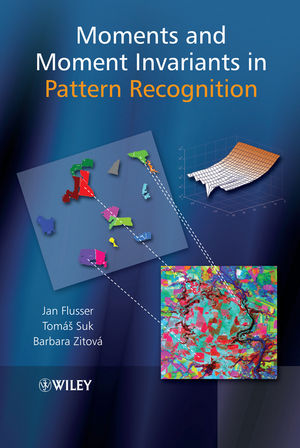Moments and Moment Invariants in Pattern RecognitionISBN: 978-0-470-69987-4
Hardcover
312 pages
December 2009
 |
||||||
Preface.
Acknowledgments.
1 Introduction to moments.
1.1 Motivation.
1.2 What are invariants?
1.3 What are moments?
1.4 Outline of the book.
References.
2 Moment invariants to translation, rotation and scaling.
2.1 Introduction.
2.2 Rotation invariants from complex moments.
2.3 Pseudoinvariants.
2.4 Combined invariants to TRS and contrast changes.
2.5 Rotation invariants for recognition of symmetric objects.
2.6 Rotation invariants via image normalization.
2.7 Invariants to nonuniform scaling.
2.8 TRS invariants in3D.
2.9 Conclusion.
References.
3 Affine moment invariants.
3.1 Introduction.
3.2 AMIs derived from the Fundamental theorem.
3.3 AMIs generated by graphs.
3.4 AMIs via image normalization.
3.5 Derivation of the AMIs from the Cayley–Aronhold equation.
3.6 Numerical experiments.
3.7 Affine invariants of color images.
3.8 Generalization to three dimensions.
3.9 Conclusion.
Appendix.
References.
4 Implicit invariants to elastic transformations.
4.1 Introduction.
4.2 General moments under a polynomial transform.
4.3 Explicit and implicit invariants.
4.4 Implicit invariants as a minimization task.
4.5 Numerical experiments.
4.6 Conclusion.
References.
5 Invariants to convolution.
5.1 Introduction.
5.2 Blur invariants for centrosymmetric PSFs.
5.3 Blur invariants for N-fold symmetric PSFs.
5.4 Combined invariants.
5.5 Conclusion.
Appendix.
References.
6 Orthogonal moments.
6.1 Introduction.
6.2 Moments orthogonal on a rectangle.
6.3 Moments orthogonal on a disk.
6.4 Object recognition by ZMs.
6.5 Image reconstruction from moments.
6.6 Three-dimensional OG moments.
6.7 Conclusion.
References.
7 Algorithms for moment computation.
7.1 Introduction.
7.2 Moments in a discrete domain.
7.3 Geometric moments of binary images.
7.4 Geometric moments of graylevel images.
7.5 Efficient methods for calculating OG moments.
7.6 Generalization to n dimensions.
7.7 Conclusion.
References.
8 Applications.
8.1 Introduction.
8.2 Object representation and recognition.
8.3 Image registration.
8.4 Robot navigation.
8.5 Image retrieval.
8.6 Watermarking.
8.7 Medical imaging.
8.8 Forensic applications.
8.9 Miscellaneous applications.
8.10 Conclusion.
References.
9 Conclusion.
Index.



